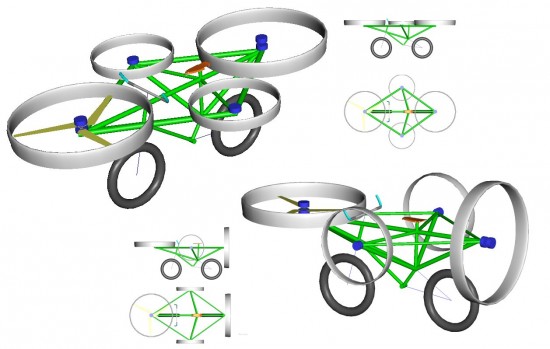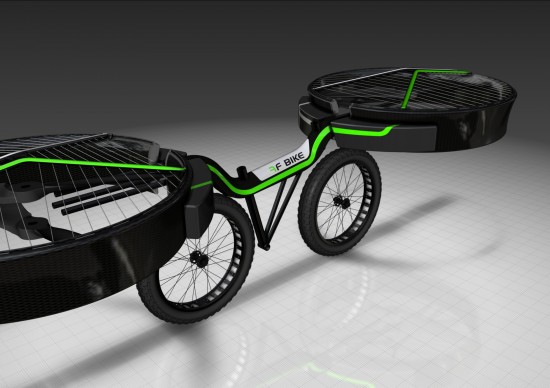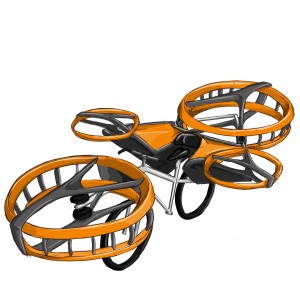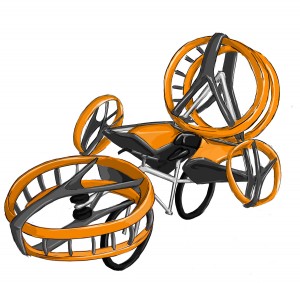Conceptual design
The course of the donceptual design development
The first draft was characterised by rather large compact frame which consisted of the main trapezoid horizontal frame carrying the propellers with bars sticking out of it, connecting it to the more or less standard bicycle frame. To reduce the total width during the ride the side propellers could be tilted to the vertical position. This proposal provided satisfactory overall rigidity, but the ergonomics did not meet the requirements.
The pilot would have to mount the bike in a complicated way (in fact, he would have to creep through the frame) and he would have a problem to reach the ground with both feet. When starting and stopping both the pilot and the bike might fall down. The first draft also brought an idea to utilize the propellant units in the riding mode by turning the rear propeller over to the vertical position. The movement forward would then be provided by the rear propeller`s thrust.

Like a common bike
Because of the above mentioned reason, i.e. unsuitable ergonomics, the first option was abandoned. Another draft emerged. It took into account almost classic bicycle frame extended to elements carrying the propellant units. The front part included a simple extension of the standard frame with a bar, while for side drives a revolving bracket that allowed tilting of the propellers was designed. The rear drive was placed into a triangular tipping frame which should secure that for the riding mode, the rear pair of propellers could be tilted to the vertical position.
Based on this technical draft a design study was developed. It drafted the visual aspect of the covering cages and casing of the space for battery and other electronics placed behind the seat.
The technical and design drafts were then further developed, but some more problematic points started to appear. The proposed solution of the covering cages turned out to be very demanding to produce (also costly) and it was necessary to simplify it significantly. The tiltable rear part of the frame required a safety lock to secure the horizontal position of the rear propeller during the takeoff. Shifting the propeller into the vertical position during the ride also combined with the position of the battery in the space behind the seat influenced adversely the centre of the bike`s gravity which could again result in both the pilot`s and the bike`s fall.
Efficient and functional design
The third draft abandoned the idea of turning over the rear propeller and proposed the use of side units to power the bike. The side units would not tilt the longitudinal axis but the transversal axis. Their performance proved to be sufficient. A little disadvantage was its total width. Another significant change was the transposition of the battery pack to the frame space (below the crossbar), which placed the centre of gravity lower and improved the weight distribution.
The last change was the replacement of the intended impact attenuation when landing. The original drafts relied on the use of a front telescopic fork and a swing rear fork (with beam gearing), both with gas-liquid dampers. Much higher weight of the flying bike, compared to a common bike, would load these standard components excessively. Special components would have to be used or be designed, which would again increase the weight of the bike significantly.

no images were found


